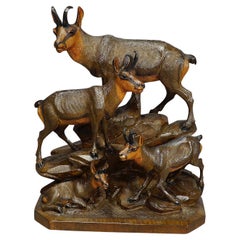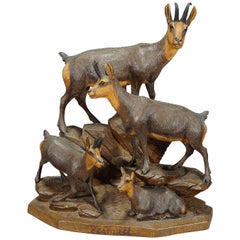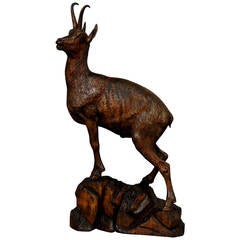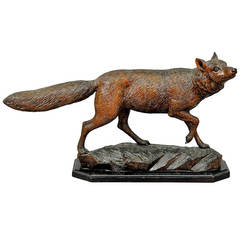Ernst Heissl
Antique Late 19th Century Austrian Black Forest Animal Sculptures
Wood
Antique Late 19th Century Austrian Black Forest Animal Sculptures
Wood
Recent Sales
Antique 1890s Austrian Black Forest Animal Sculptures
Wood
Early 20th Century Austrian Black Forest Animal Sculptures
Wood
People Also Browsed
21st Century and Contemporary Chinese Books
Paper
21st Century and Contemporary Books
Paper
Antique Late 19th Century English Victorian Windows
Glass, Stained Glass
Antique 1880s English Models and Miniatures
Wood
Antique 19th Century French Gothic Mantel Clocks
Alabaster, Ormolu
Antique 1880s Italian Louis XVI Paintings
Canvas, Wood
Antique Early 1900s Swiss Black Forest Mounted Objects
Wood
Antique 19th Century Paintings
Canvas, Giltwood
Antique Late 19th Century Swiss Black Forest Cigar Boxes and Humidors
Fruitwood
20th Century Taxidermy
Animal Skin
Antique 19th Century English Victorian Umbrella Stands
Brass
Vintage 1940s Danish Hollywood Regency Sterling Silver
Gold Plate, Silver, Sterling Silver
Mid-20th Century German Black Forest Table Lamps
Canvas, Jute, Wood
21st Century and Contemporary British Victorian Books
Paper
20th Century European Books
Paper
Antique Late 19th Century Italian Victorian Figurative Sculptures
Shell
A Close Look at Black-forest Furniture
Although its name evokes a mountainous region in Germany, antique Black Forest–style furniture originated in Switzerland. In Brienz, during the early 19th century, wood-carver Christian Fischer recognized the market for tourist souvenirs and helped make the village into a wood-carving destination. The Brienz Woodcarving School was founded in 1884 and had its own small zoo for studying the anatomy of animals, depictions of which are a defining aspect of the style, also known as Brienzerware.
Whimsical sculptures, often depicting bears and other Alpine animals like stags, owls, deer and boars, characterize the work produced in the area. Along with folk art and decorative objects, Black Forest furniture included benches held aloft by bears, umbrella stands carved with acorns and clock cases adorned with scrolling oak leaves. While most wood-carvers adhered to a similar realism in their designs and woods like linden, maple and walnut, their aesthetics varied.
The F. Peter Trauffer family was known for their hand-carved bear sculptures that saw the furry mammals playing instruments, smoking pipes and engaging in all sorts of human activities. They were sometimes detailed with glass eyes and integrated into functional pieces of furniture, including chair backs and bench legs, which generations of cabinetmakers created from the 1880s to the 1950s. Walter Mader and his son Heinrich frequently carved Saint Bernard sculptures that they incorporated into furniture.
As the Black Forest furniture style spread around the world through exhibitions at world’s fairs in the 19th and early 20th centuries, the rusticity of these pieces resonated at a time of increasing urbanization, inspiring other artisans.
Find a collection of antique Black Forest cabinets, bedroom furniture, seating and other items on 1stDibs.
Finding the Right Animal-sculptures for You
Invite the untamed wonders of the animal kingdom into your home — and do so safely — with the antique, new and vintage animal sculptures available on 1stDibs.
Artists working in every medium from furniture design to jewelry to painting have found inspiration in wild animals over the years. For sculptors, three-dimensional animal renderings — both realistic and symbolic — crisscross history and continents. In as early as 210 B.C., intricately detailed terracotta horses guarded early Chinese tombs, while North America’s native Inuit tribes living in the ice-covered Arctic during the 1800’s wore small animal figurines carved from walrus ivory. Indeed, animal sculpture has a long history, and beginning in the 19th century, the art form started becoming not only fashionable but artistically validated — a trend that continues today. At home, animal sculptures — polished bronze rhinos crafted in the Art Deco style or ceramic dogs of the mid-century modern era — can introduce both playfulness and drama to your decor.
In the case of the frosted glass sculptures crafted by artisans at legendary French glassmaker Lalique, founded by jeweler and glass artist René Lalique, some animal sculptures are purely decorative. With their meticulously groomed horse manes and detailed contours of their parakeet feathers, these creatures want to be proudly displayed. Adding animal sculptures to your bookcases can draw attention to your covetable collection of vintage monographs, while side tables and wall shelving also make great habitats for these ornamental animal figurines.
Some sculptures, however, can find suitable nests in just about any corner of your space. Whimsical brass flamingos or the violent, realist bronze lions created by Parisian sculptor Antoine-Louis Barye are provocative and versatile pieces that can rest on windowsills or your desk. Otherwise, the brass cat shoehorns and bronze porcupine ashtrays designed by Viennese artist Walter Bosse are no longer roaming aimlessly throughout your living room, as they’ve found a purpose to serve.
Embark on your safari today and find a fascinating collection of vintage, modern and antique animal sculptures on 1stDibs.



